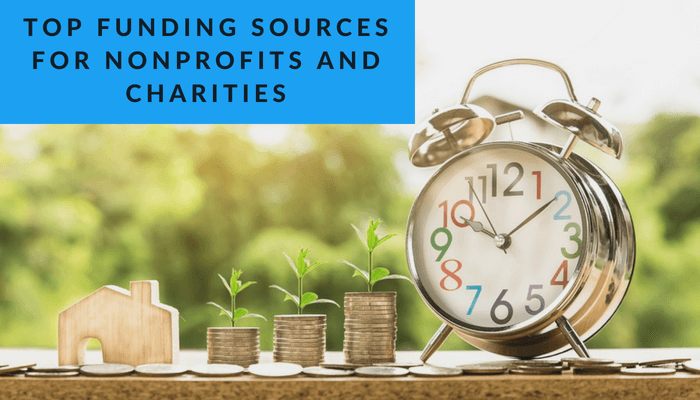What Does Non Profit Organization Do to Get Funding

For nonprofit professionals, identifying funding sources and deciding on the correct funding model for their organization is ane of the most challenging tasks at hand. Making decisions about the correct approach to treatment nonprofit finances is not easy.
Every system needs coin to stay adrift. Nonprofits are no exception to this rule. Coin is a frequent topic of conversation amongst nonprofit professionals, and discussions about finances get fifty-fifty more heated during economically unstable times.
On one hand, there is seemingly a multitude of funding models to choose from – which tin create some confusion. On the other hand, some nonprofits even so experience 'stuck' and limited in their options.
What is a "funding model"?
Bridgespan defines a "funding model" as a methodical and institutionalized approach to building a reliable revenue base that will back up an organization's core programs and services.
In essence, a nonprofit "funding model" combines unlike funding sources into a constellation unique to every nonprofit. For example, one nonprofit might be funded 50% through grants, 30% through events, fifteen% through a membership program, and 5% through in-kind donations. Some other one might be 70% funded through a major donor program, 20% through direct mail fundraising, and 10% through events. Unlike types of nonprofits are suited to different funding sources, depending on their mission and programs.
How to cull the right "funding source" for your nonprofit?
While it'southward a mutual practice among most nonprofits to seek funding from multiple sources, research has shown that 90% of the largest nonprofits have embraced funding models built around a single dominant source of revenue.
We often hear it's proficient to "diversify revenue streams". But information technology can be hard to know what this really ways in do.
v Steps to Select a Funding Source for your Nonprofit:
Step ane: Program, don't firefight.
Many nonprofit organizations are guilty of reactive fundraising. Nothing is a substitute for thoughtful planning. Take some fourth dimension to think about your funding model before you start going through the motions of fundraising. If you're already raising funds, you can take the time to reevaluate your funding model.
Step two: Appraise and evaluate.
Beginning from where you are. Take a look at what you're already doing. Realistically assess your current funding sources. Are they all aligned to your mission, vision, and values? Do they all evangelize a proficient return on investment? Is at that place infinite for investigating other funding sources? What about moving away from some?
Pro tip: Data is your best friend here. Pull up relevant metrics and assess your fundraising efforts.
Step 3: Explore.
Organize brainstorming sessions with your team. Go creative and retrieve outside of the box. Look at what other like organizations are doing and see if there's something that could work for yours.
Step 4: Analyze.
Consider how much you tin realistically fundraise from each funding source. Narrow downwardly your brainstorm to a set of funding model options that are sustainable, replicable, and feasible.
Step v: Select and brainstorm.
Commit to pursuing one or two of the models on your shortlist and develop an implementation plan that will brand your funding model plans actionable.
A thought-through and well-defined funding source can aid your organization better position itself to attract funds, ensure long-term sustainability, and increase impact.
By intentionally choosing a funding model, yous tin strategically focus your evolution efforts on the most promising funding sources and build the internal capacity needed to make the most of them.
Nonprofits tin can utilise these half-dozen Main Funding Sources to help fulfill their mission:
- Individual Donations
- Grants
- Corporate Sponsorships
- Membership Fees
- Selling Appurtenances and Services
- In-kind Donations
1. Individual Donations
Of all donations made to nonprofits, 71 percent comes from individuals. (The Balance)
Individuals gave more than $309.66 billion in 2019, co-ordinate to NP Trust, making private charitable contributions one of the best nonprofit funding sources. Individual giving is predicted to increase past 4.7% in 2021 co-ordinate to Philanthropy Outlook.
For this reason, information technology'southward wise to focus on individual donors and brand them a fundamental focus of your funding model.
Private donors can make ane-time or recurring donations. They also give in a multifariousness of ways: online and offline, through events, auctions, planned giving, and more. When it comes to private donations, it'southward of import to comprehend all your bases, since individual gifts brand up such a big function of a nonprofit's funding. For the most part, this is a very effective funding source, specially for those organizations with large marketing budgets and those with causes that have a wide entreatment (east.m. cancer).
1.i. Types of individual donors
Tap into all categories of individual donors, from major donors to regular donors.
1.one.1 Major donors
Sometimes, a nonprofit venture can brainstorm with a large cash infusion from a single major donor. This is great to get a nonprofit from the idea stage to implementation. If yous started out this manner or yous currently rely on a unmarried major donor for funding, think and plan carefully for the point at which you will demand to transition to new funding sources.
Although you don't want to be overly reliant on major donors, information technology's still smart to ensure that your funding source nurtures major donors.
Cultivating major donors is a bit of a unlike ordeal compared to cultivating regular donors. To prospect, major donors, consider investing in wealth screening software. If possible, consider appointing a team fellow member to work with major donor leads.
1.1.two Regular donors
Regular donors usually requite more frequently but their gifts are smaller in size. They ofttimes make up the majority of the donor base and can be quite various in age, socio-economical background, and interests. This is why it'southward crucial to collect and analyze information about your donor base. To cultivate regular donors, you volition likely accept to employ a multitude of donor conquering and donor memory techniques.
Regular donors are either "i-off" donors or recurring donors. Many nonprofit experts recommend that you go regular donors to become recurring donors. This provides your nonprofit with sustained income and therefore allows yous to amend plan your activities.
ane.1.3 Fee for service
Many nonprofits, depending on what they're offer, merely must charge at least a sliding scale fee to embrace either the services or goods they are providing. Examples include certain hospitals or public health clinics. You lot may as well consider a sliding scale of prices based on the recipient's income.
Consider if this is a possibility for your nonprofit, but practice your research and go on your beneficiaries in mind: Volition they exist willing to pay the price you've set?
1.one.4 Alumni
This funding source works especially well for organizations such every bit universities and hospitals that serve a large community with a high turnover. If your nonprofit organisation serves a large grouping of people that laissez passer through and benefit from information technology frequently and consistently, it might be that they would like to give back and help others receive the same benefits or assistance that they did.
i.1.5 Volunteers
According to the nonprofits source, approximately 63 meg Americans — 25% of the adult population — volunteer their time, talents, and energy to making a difference. The value of all those hours was approximately $193 billion.
While "volunteer hours" aren't technically a funding stream, your system might want to view information technology as one. For example, volunteer hours can reduce the amount of funding you'll need to raise for a item programme/service.
1.ane.6 Planned giving
Planned giving is known past many names: bequest giving, gift planning, deferred giving, legacy giving, and estate planning. They all refer to someone leaving something to your nonprofit organization in their will. These donations tend to exist larger and therefore the time and attempt to establish the connection and commitment needs to start well earlier the individual'south terminate of life.
With the right strategy and efforts in place, this tin can abound to become a significant slice of your fundraising pie.
one.two Online or Offline Donations
You can receive private donations online or offline. While online fundraising grows 24-hour interval-by-day, and more individuals seek information online, don't be quick to dismiss traditional fundraising.
The all-time results are commonly seen when you combine both traditional and modernistic fundraising techniques.
ane.2.1 Online fundraising
-
Website
When you're non running a specific entrada (and fifty-fifty when you lot are), your website is your best bet. It's the permanent home to your online fundraising efforts. Information technology's crucial to invest fourth dimension and effort to make your website and online donation folio shine. Make sure that the potential donor encounters a user-friendly website and has a smooth experience. Don't hibernate your donation button! A donor should exist able to observe your donation link within a couple of seconds of your donation folio loading.
Read more about how to design a great donation page here.
Get Started With Donorbox
-
Crowdfunding
In simplest terms, crowdfunding is all about many individuals each making a small-scale donation – $x, $50, $100, maybe more. Crowdfunding has become popular with the proliferation of various online platforms for fundraising and is used both by corporate organizations and nonprofits.
There are many different types of crowdfunding, but the one near used by nonprofits is donation-based crowdfunding. To get the nigh out of donation-based crowdfunding, post regular updates, share via e-mail, and on social media. Brand certain to tell a story – a story is what fuels a crowdfunding campaign.
Crowdfunding frequently helps get your nonprofit known to potential donors that otherwise wouldn't have known about your system.
Crowdfunding appeals tin exist fourth dimension-consuming when done properly. Although the setup is free, crowdfunding sites charge fees for the privilege of collecting donations through their site. Finally, due to its growth, crowdfunding is a saturated marketplace.
-
Peer-to-peer fundraising
Peer-to-peer fundraising is a sub-category of crowdfunding. Instead of having one crowdfunding page where everyone donates, with peer-to-peer fundraising, individual fundraisers commonly prepare personal fundraising pages to accept donations, which are so received by your nonprofit.
This strategy encourages supporters to accomplish out to their peers, friends, coworkers, and family unit members for donations.
Peer-to-peer fundraising is effective considering it builds on relationships, uses your already-existing donor base. Peer-to-peer fundraising as well works well considering it'due south exponential. All the individual campaigns past your supporters ripple outwards and bring in more donors.
I of the major drawbacks of peer-to-peer fundraising is the effort information technology takes to train fundraisers. It can also be challenging to clearly articulate and transmit your nonprofit's mission, vision, and values to dozens of individuals well enough so that they can continue sharing information technology in the aforementioned style.
-
E-mail marketing
Study later on study puts email marketing as the most constructive way for nonprofits to build awareness, learn leads, raise funds, and retain current donors.
Email marketing services are more often than not free for smaller nonprofits. And even when the e-mail listing grows in size, electronic mail marketing remains very cost-effective. Furthermore, email marketing tools have become and so intuitive – with professionally designed templates, drag and drop features, and other easy-to-utilize editors. Compared to other types of fundraising, e-post marketing acquires customers, supporters, donors, and volunteers faster. Due east-mails are also easily customized/personalized.
On the other side, we are swamped with dozens of emails every twenty-four hours, including fundraising and advancement emails. Therefore, even though the number of subscribers is growing, the date rates are dropping. This ways organizations demand to get increasingly skilled at capturing their readers' attention.
-
Monthly giving
I advantage of the motion to online giving has been the facilitation of painless recurring giving programs.
Monthly giving (otherwise known equally recurring giving) reigns supreme. Although big donations are valuable and should however be pursued, recurring giving programs provide a reliable source of income for your nonprofit. That's why developing a great monthly giving program is a great investment that can have a tremendous touch on the long-term financial health of your organization.
When a donor sets up a recurring donation, they choose to give a pre-adamant amount of coin on a regular footing. Many people similar to give monthly, bi-monthly, or yearly, but they can give as frequently as they'd like. Monthly giving is probably the well-nigh frequent form of recurring giving.
Pro Tip: Inquiry & Clarify some of the top donation tools for nonprofits & choose a donation software that has features such every bit monthly giving, Crowdfunding, Text-to-Give, online donation forms, etc.
i.2.two Offline fundraising
-
Direct Mail service
This offline fundraising method is still used by nonprofits since information technology'due south still effective for certain donor segments. Information technology's especially useful for smaller nonprofits or nonprofits that operate locally. Additionally, older donors are more likely to prefer direct mail. If your nonprofit has an older donor pool, you could find direct mail highly effective.
Directly mail service gives you lot a chance to provide in-depth data to your donors – that can't be conveyed in a text, Tweet, Facebook advertising, or fifty-fifty an e-mail.
Nevertheless, direct mail tin exist pricey, specially when compared to e-mail marketing, for instance. Direct postal service too takes time – y'all have to write the letters, hone the list, track responses, remove people from your list, keep the addresses up to date, and more.
Postal postal service likewise doesn't pack quite the same punch as it one time did, with many donors tossing their mail service aside after a cursory glance. To capture attention, you lot need to stand out; and to stand out – you need to pay money (due east.m. for a graphic designer to design a compelling postcard).
-
Events
Fundraising through events has become increasingly popular in the nonprofit community. Whether a nonprofit is hosting a walk-a-thon, gala dinner, art exhibition, concert, or field twenty-four hour period, or a hike-a-thon, events provide an avenue by which donors and potential donors can interact in person and learn more about the system.
Donors are more likely to give if they can put names to faces. Since events are generally perceived equally fun, they normally concenter a large number of people. Events also aid heighten an organization'south visibility and make. They assistance build upwardly the mailing list and can boost online fundraising too.
Events aid build esprit amongst the constituency, help organizations meet and dazzle new prospective donors, too every bit deepen their relationships with key donors.
However, events are ordinarily labor-intensive and crave a lot of detailed planning. An event can also exist ruined because of the weather, a competing event on the same day, a guest non showing upwardly, and many other details over which you accept footling control.
-
Door-to-door
Although door-to-door fundraising has macerated over the years due to its resources-intensive nature, it's still utilized successfully by many organizations, especially political organizations.
Door-to-door solicitation, in general, works all-time for campaigns or programs that straight touch the people being approached. Information technology can be targeted in terms of audience, which reduces donor attrition. Door-to-door canvassing enables a i-on-one, contiguous interaction with potential donors/constituents that is unattainable through direct mail service, electronic mail, and the Cyberspace.
However, door-to-door canvassing is one of the tiptop reasons people have a poor impression of nonprofits. Some donors cite door-to-door solicitation as intrusive. A total-fourth dimension, door-to-door canvassing operation is besides quite labor-intensive and requires very enthusiastic and educated volunteers (which can be hard to accomplish).
-
Telephone solicitations
Phone solicitations are donation requests fabricated over the phone, ranging from i employee making a couple of 'give thanks you' calls to big telemarketing campaigns. Like door-to-door fundraising, this technique has macerated over the years every bit online fundraising grows, simply it can still be effective for some nonprofits.
Phone calls are as personal as information technology gets. With phone solicitation, gifts are ofttimes big. Information technology'southward scalable, equally the numbers can grow over time. Calling donors tin can increase a fundraiser'southward current donor base and increase gifts, get lapsed donors back on board, improve memory, catechumen donors to monthly donors, and is the perfect manner to welcome and say thanks plus generate feedback from donors.
However, phone calls are very labor-intensive. Some donors are also quite averse to phone solicitation. Therefore, if fundraisers using phone solicitations are not tactful and skilled, they can do more impairment than good. Finally, not everyone who pledges coin over the phone will really deliver.
one.2.three. Special types of fundraising
-
Capital campaigns
A capital entrada is a time-limited effort past a nonprofit organization to heighten significant dollars for a particular project, such every bit funding a new building or raising funds for a (very big) specific project.
Capital campaigns take a beginning and an end but oft bridge several years. A capital entrada employs all the usual means of raising funds such equally straight mail and direct solicitation. Capital campaigns require extensive preparation and proficient execution.
-
Text-to-give
Text donations are donations that donors can make via their mobile phones. Unremarkably, donors text a keyword and/or an amount to a dedicated number. They are then unremarkably sent the link to the organization's mobile-responsive donation folio. Once a donor fills out their info on this class, they never have to make full it in again. There are also text-to-give platforms that don't require filling in a class (where donors tin ostend the donation by simply texting back "yes").
Text-to-give is piece of cake and user-friendly. Donations by text are somewhat similar impulse purchases; which means that nonprofits don't have to capture donors' attention for very long.
However, software, licensing, and transaction fees can potentially add up to v-10% of the total donations received. Additionally, there'southward ofttimes a cap on all donations; some providers will only process donations as low every bit $v and as high as $10.
And finally, there's no system for capturing donor data to help you keep building on the relationships initiated through text-to-give.

2. Grants
Nonprofits can use for grants from the government at local, state, and federal levels as well equally individual and public foundations. Generally, yous are non required to repay any money awarded to you through a grant. In almost every state in the world, in lodge to be awarded a grant, your organisation needs to have charitable/nonprofit condition.
Oftentimes, grants volition exist restricted to a certain sector, location, or type of programming. For this reason, nonprofits must search for grants advisable for their organization and use for consideration.
Here are some of the main types of grant-giving organizations:
- Governments
- Public charities
- Community foundations
- Family unit foundations
- Individual foundations
Every grant-giving system volition have different requirements, and those can also depend on the country in which your nonprofit is registered.
Pros
- Grants can fuel large projects, enabling large-calibration societal impact that wouldn't otherwise be possible.
- Grants from a government agency can give your organisation more credibility, which is helpful in securing more than nonprofit funding from other sources.
- Most grants require no repayment as long as funds are spent as outlined.
Cons
- Grants can have a significant amount of time. Information technology offset takes time to develop grant-writing skills that actually win grant proposals, it takes time to write a winning awarding, and then information technology tin can take time for yous to run into the funds.
- They come with specific conditions fastened. These conditions apply to things similar how exactly you can utilize the money. They also have specific reporting requirements that you should consider before applying. The conditions can also exist related to item outputs or outcomes or achieving agreed milestones.
- Grants are meant for specific brusk-term purposes, not to be a permanent nonprofit revenue stream.
Grants can exist very highly-seasoned to nonprofits, but they do need some thought before you utilise for them.
Things to consider before deciding to apply grants every bit office of your fundraising/financing model:
- Are we able to invest resource in writing winning grant applications?
- Tin we meet the grant conditions?
- Are the activities nosotros would conduct consistent with our mission, our aims, and our strategy?
- Can the activity continue after the grant funding ends?
- Exercise we take other reliable income streams?
For some organizations, grants will be the platonic source of funding, whereas some will discover them too cumbersome and restrictive. This is why it'south important to answer the questions to a higher place to make sure grant funding is what'due south best for your nonprofit at this bespeak in fourth dimension.
Extra Resources:-
- How to Find Grants for your Nonprofit
- Engineering science Grants for Nonprofits
If you're based in the United States, the US government has a searchable online database of government grants to assistance y'all find what you need. Foundation Center is particularly useful for its all-encompassing directory and free resources.

3. Corporate Sponsorships
Corporate sponsorships can be an excellent source of funding for nonprofits.
Corporations are usually keen to partner on projects to better their philanthropic epitome or to piece of work on becoming a more socially responsible organisation. Corporate social responsibility (CSR) is more important than ever as consumers have become more probable to buy from socially responsible companies.
Different corporations will have unlike giving programs – some of which may work for your organisation.
There can be some reluctance effectually partnering with corporations. Nevertheless, in that location are many socially responsible corporations out there. As long equally you accept donations from those aligned with your nonprofit's mission and values, this can exist a valuable funding source.
Value alignment is especially important since today'south donors need transparency, and being very careful about whom you lot choose to partner with can safeguard your reputation later downwardly the line.
Corporate support comes in many forms:
- Philanthropic – no-strings-fastened donation, like to individual giving
- Result sponsorship – episodic or brusk-term support, typically outcome-based
- Cause marketing – longer-term thematic engagement
- Pro bono – corporate professionals offer their expertise/services
- Matching gifts– when corporations match donations made by their employees
- Paid release – when companies employees a few paid release days each year, allowing an employee or many employees to spend a day or 2 volunteering during regular work hours
- In-kind gifts – when companies requite product donations rather than cash contributions
- Check-out campaigns – consumers requite at the cash annals when checking out
Substantially, through the many unlike forms of corporate sponsorship, your nonprofit tin can enhance money, gain in-kind donations and gifts such as furniture, office equipment, marketing advice, consulting services, or website development support, to name a few. In exchange for their sponsorship, your nonprofit can put their logo on your website, display their logo at your events through banners or on t-shirts, or requite them an honorable mention on your blog and social media platforms.
When considering corporate sponsorships as ane of the funding sources for your nonprofit, don't forget to consider the overhead costs – someone will need to manage the partnerships, specially if you're thinking of making corporate partnerships one of your master sources of income.
Pro tip one: Your lath can exist an excellent source of business organisation contacts. Inquire your board members to introduce you to potential sponsors.
Pro tip 2: It'south slap-up to think big and achieve out to large corporations. Merely don't forget about small businesses besides, especially if your nonprofit is smaller or locally based.

4. Membership Fees
This nonprofit funding source won't necessarily piece of work for every blazon of nonprofit, just it's worth looking at.
Consider the mission and the master activities of your nonprofit, and and then decide whether y'all want to utilize the membership fees revenue stream.
This nonprofit funding source is particularly constructive if your nonprofit tin can offer exclusive programs or benefits to its members.
Membership fees may be charged by some types of nonprofits. At that place are more than thirty types of nonprofits in the The states Taxation Code. Some provide services for their members for which they charge a membership fee. Examples include the 501(c)(7) Order and the 501(c)(six) Business organisation Clan.
Pros
- Membership programs provide a abiding source of revenue for your arrangement.
- This funding source is immediate and unrestricted.
- Memberships requite people a fashion to have an intimate, ongoing relationship with your organization.
Cons
- Managing a nonprofit membership program takes time and effort. Members ofttimes look special treatment.
- Offer benefits and perks can go expensive. All those mailings, t-shirts, and mugs can add up.
A sub-category of the membership model is funding through past beneficiaries or alumni. This model works particularly well for hospitals and universities, who incite a sense of 'giving back' in their past beneficiaries.
This particular 'past beneficiaries' funding source, therefore, works if your organization serves a large customs with a high turnover. In this regard, Princeton Academy is a stellar example.
The academy has become very adept at borer alumni for donations, boasting the highest alumni-giving rate among national universities—59.2 percent. In 2008, more than 33,000 undergraduate alumni donated $43.half-dozen million to their alma mater. As a upshot of the school's fundraising prowess, more than 50 percentage of Princeton's operating budget is paid for by donations and earnings from its endowment. (Bridgespan – Barbara Christiansen, Peter Kim, William Foster)
This works because Princeton Academy'south past beneficiaries feel like they've received slap-up value from the institution in the by, and are keen to help others receive the aforementioned benefits. By beneficiaries meet the private benefit they received in the past every bit serving the higher social practiced.
Before deciding to use membership fees, in 1 capacity or some other, as a funding source, ask yourself the following questions:
- Do we run programs that produce loyal supporters and evangelists?
- Can we invest in building long-lasting relationships with our beneficiaries?
- Do we have the capacity to reach out to beneficiaries subsequently they cease using our services?
- Exercise we offer sectional perks and benefits to justify a membership fee?

v. Selling Goods and Services
Another funding source your nonprofit can consider is selling goods and/or services. This funding source is subject to many regulations past the IRS.
Large, institutional organizations are more than likely to benefit from fees and sales of products; while smaller charities depend on this type of revenue to a much lesser extent.
For example, you can sell branded goods to bring revenue to your organization. These items typically include t-shirts, tote numberless, mugs, cookies, and other items. For example, Goodwill Industries is probably the largest nonprofit retailer.
Many nonprofits besides charge fees for some of their services.
East.1000. Hospitals pecker patients, museums ask for admissions fees, theatres sell tickets, civic organizations charge dues, colleges crave tuition and then on.
Selling goods and services is sometimes also chosen 'trading' or 'earned income'.
Here are more examples of selling goods and services:
- Selling tickets to events
- Creating and selling publications
- Selling in-firm expertise e.g. writing, training, consultancy
Nonprofits can trade in most countries. Still, if selling goods and services make up a pregnant portion of your upkeep, seek expert advice. If these activities are non related to your primary purpose, there are clemency and tax law implications. Keep track of the percentage of your organization's income that comes through goods and services. Earned income must be related to the mission of the organization, or it tin can be taxed every bit unrelated business income.
This can exist a cracking source of income for your nonprofit, but as ever, this funding source is not ever applicable to every nonprofit.

six. In-kind Donations
In-kind donations will non be helpful to every type of nonprofit merely can be an invaluable source of support for nonprofits like animate being shelters, homeless shelters, condom houses, or humanitarian relief organizations.
Examples of in-kind donations include food, vesture, and medicine. If in-kind donations work for your organizational model, they can save yous many dollars. For example, if your organization seeks to bring nutrient and water into areas struck by natural disasters, getting in-kind supplies is most certainly useful.
It tin can exist the example that you can't directly use the in-kind donations for your programs. In this case, you could ever employ them in auctions (depending on the blazon of items). If you cull to do this, you have to clearly communicate (ideally on your website) which items yous're able to take, and where are your drove points – if not at your offices.
Information technology's important to annotation that in-kind donations do not only include items like food, clothing, and medicine. An in-kind donation tin can be someone delivering a speech or a workshop for gratis or someone building your website at no cost.

Determination
While opinion varies as to what is the "ideal" nonprofit funding source, utilizing several diverse funding sources to achieve sustainability is generally a practiced do.
It's advisable for nonprofits to never receive more than 30 percent of their funding from whatever one source. If an organization loses 30 percent of its revenue, it could probably restructure in order to survive.
It's of import to proceed in mind that in this article we've outlined possible nonprofit funding sources, not necessarily financial models for running a nonprofit. If you'd like to learn more about financial models, read this article By William Landes Foster, Peter Kim, and Barbara Christiansen.
When information technology comes to securing funds for your nonprofit, you should always make certain to have a plan in place. Invest in relationships with donors, whether they are individuals, foundations, corporations, or regime funders. All of these relationships accept time to develop and need to be cultivated. You should respect every kind of support.
We promise this commodity helped you begin to understand your options so y'all can first choosing your ideal funding sources.
Whichever model you lot choose, it's of import to brand sure it is correct for your nonprofit – the right funding model should help you evangelize your mission and sustain your activities.
Please reach out to our Donorbox team if y'all have any questions or concerns that we might help you with!

Source: https://donorbox.org/nonprofit-blog/nonprofit-funding-sources/
0 Response to "What Does Non Profit Organization Do to Get Funding"
Post a Comment